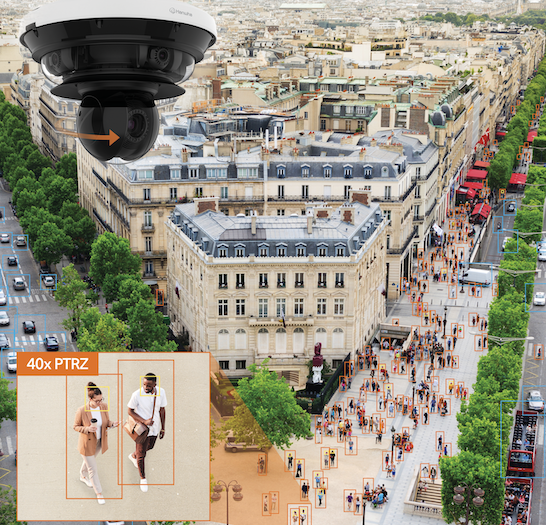
Security teams face increasing demands to protect complex environments while managing tight budgets. Imagine a bustling city centre, with thousands of pedestrians, vehicles, and activities happening simultaneously. Security here is critical for crime prevention, public safety, and monitoring high-traffic areas such as public squares, shopping streets, and transportation hubs.
Scenario A: Traditional Multi-Camera Setup
In a traditional setup, a city centre would require numerous standalone cameras to monitor various zones, including pedestrian crossings, bus stops, public parks, and retail areas. Each camera would need its own power supply, network connection, and video management system (VMS) license. Installing such a system across a sprawling urban landscape involves complex cabling, extensive infrastructure work, and high upfront costs. Maintaining these cameras is equally demanding, with technicians needed to manually adjust each unit for optimal coverage. This results in a costly, labor-intensive system that is not always flexible to rapidly changing urban environments or evolving threats.
Scenario B: Hanwha Vision’s Multi-Directional AI Cameras
Now imagine the same city centre equipped with Hanwha Vision’s multi-directional AI cameras. A single, strategically placed multi-directional camera can simultaneously monitor multiple zones—such as a busy public square, a shopping street, and nearby bus stops—using its multiple lenses and advanced AI analytics. This drastically reduces the number of cameras required to cover large areas and eliminates the need for multiple VMS licenses, power supplies, and network connections.
The PTRZ (pan, tilt, rotate, zoom) remote adjustment feature allows security personnel to modify camera settings and angles remotely without needing technicians on the ground. This capability not only reduces installation time and cabling costs but also slashes maintenance expenses by eliminating the need for physical visits to the camera sites for adjustments.
In this scenario, the city centre benefits from a streamlined, cost-effective surveillance system that offers comprehensive coverage, advanced AI analytics, and reduced operational costs. Hanwha’s multi-directional cameras simplify urban security by offering wide-area monitoring with fewer devices, ensuring safety and security without the complexities of a traditional multi-camera setup.
Cost Savings and Simplified Maintenance
Hanwha’s multi-directional AI cameras are cost-effective. Instead of having a traditional surveillance system with multiple cameras, each with its own power supply, cabling, and licenses, Hanwha’s solution consolidates these needs into a single unit, reducing infrastructure requirements and lowering energy consumption.
The cameras also come equipped with PTRZ remote adjustment capabilities. This feature allows systems integrators to adjust camera settings, lens positions, and viewing angles remotely through a web viewer, eliminating the need for on-site visits for minor adjustments. This remote functionality enhances operational efficiency and reduces maintenance costs.
AI-Driven Efficiency and Versatile Applications
Equipped with advanced AI, the multidirectional cameras perform analytics directly on the device, known as Edge AI. This reduces server load and strengthens cybersecurity. The AI capabilities allow the cameras to detect and classify objects accurately, reducing false alarms and ensuring that security personnel are alerted only to genuine threats. Combined with Hanwha’s smart compression and noise reduction technologies, these features make the cameras highly effective in various environments, from large city centres to compact indoor spaces.
Multi-directional AI cameras are particularly well-suited for monitoring large and complex environments like city centres, airports, traffic intersections, and busy logistics yards.
The 5-channel model, the PNM-C34404RQPZ, offers extensive coverage through a combination of PTZ and fixed cameras. This model delivers detailed image quality up to 4K, along with a powerful suite of AI analytics, making it ideal for scenarios requiring wide-area monitoring and the ability to zoom in on specific incidents.
These cameras are also adaptable to indoor environments, such as retail stores, offices, and areas with low ceilings. Hanwha Vision’s “mini” multi-directional, compact, and discreet AI models can be seamlessly installed in spaces where aesthetics are important. Despite their small size, these models can provide up to four different video streams, offering a wider field of view than a single camera. This capability allows operators to monitor a scene more efficiently without switching between multiple camera feeds.
Moreover, the multi-directional AI cameras feature independent infrared (IR) zones and long-range IR capabilities, ensuring clear visuals even in darkness. The ability to manually adjust the intensity of each IR zone prevents reflections and optimises image quality, giving operators a clear view of their sites regardless of lighting conditions. This feature is particularly valuable in environments with varying light levels, such as outdoor perimeters, parking lots, and warehouses.
Hanwha’s multi-directional AI cameras represent a smart investment for businesses seeking cost-effective, reliable, and intelligent surveillance solutions.
Find our more here.






